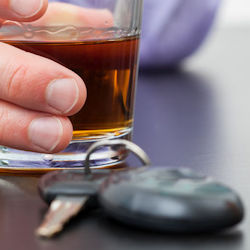Drunk Driving
Alcohol is a substance that reduces the function of the brain, impairing thinking, reasoning, and muscle coordination and is responsible for around 28% of all vehicle accidents. All these abilities are essential to operating a vehicle safely.
The legal limit for blood alcohol concentration (BAC) while driving in the United States is typically 0.08%. This means that if a driver's BAC is 0.08% or higher, they are considered legally impaired and can be charged with driving under the influence (DUI) or driving while intoxicated (DWI). For commercial drivers, the legal limit is lower, usually 0.04%, and for drivers under the legal drinking age of 21, a zero-tolerance policy often applies, meaning any detectable alcohol can result in legal consequences.
The Effects of Alcohol on Driving
BAC is measured with a breathalyzer, a device that measures the amount of alcohol in a driver's breath or by a blood test. Click on the button to see the effects blood alcohol concentration has on driving.
| Blood Alcohol Concentration (BAC) in g/dL | Typical Effects | Predictable Effects on Driving |
|---|---|---|
| .02 | Some loss of judgment; relaxation, slight body warmth, altered mood | Decline in visual functions (rapid tracking of a moving target), decline in ability to perform two tasks at the same time (divided attention) |
| .05 | Exaggerated behavior, may have loss of small-muscle control (e.g., focusing your eyes), impaired judgment, usually good feeling, lowered alertness, release of inhibition | Reduced coordination, reduced ability to track moving objects, difficulty steering, reduced response to emergency driving situations |
| .08 | Muscle coordination becomes poor (e.g., balance, speech, vision, reaction time, and hearing), harder to detect danger; judgment, self-control, reasoning, and memory are impaired | Concentration, short-term memory loss, speed control, reduced information processing capability (e.g., signal detection, visual search), impaired perception |
| .10 | Clear deterioration of reaction time and control, slurred speech, poor coordination, and slowed thinking | Reduced ability to maintain lane position and brake appropriately |
| .15 | Far less muscle control than normal, vomiting may occur (unless this level is reached slowly or a person has developed a tolerance for alcohol), major loss of balance | Substantial impairment in vehicle control, attention to driving task, and in necessary visual and auditory information processing |
For more information about drunk driving statistics and laws in your state, see the CDC's Sobering Facts: Alcohol-Impaired Driving State Fact Sheets.
Knowledge Check Choose the best answer for the question.
1-3. What is the typical legal limit for the blood alcohol concentration (BAC) for adults while driving?
You forgot to answer the question!

